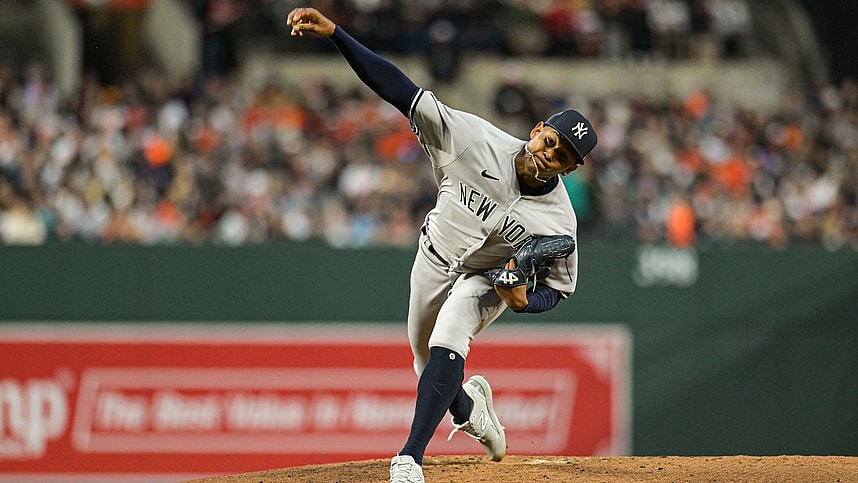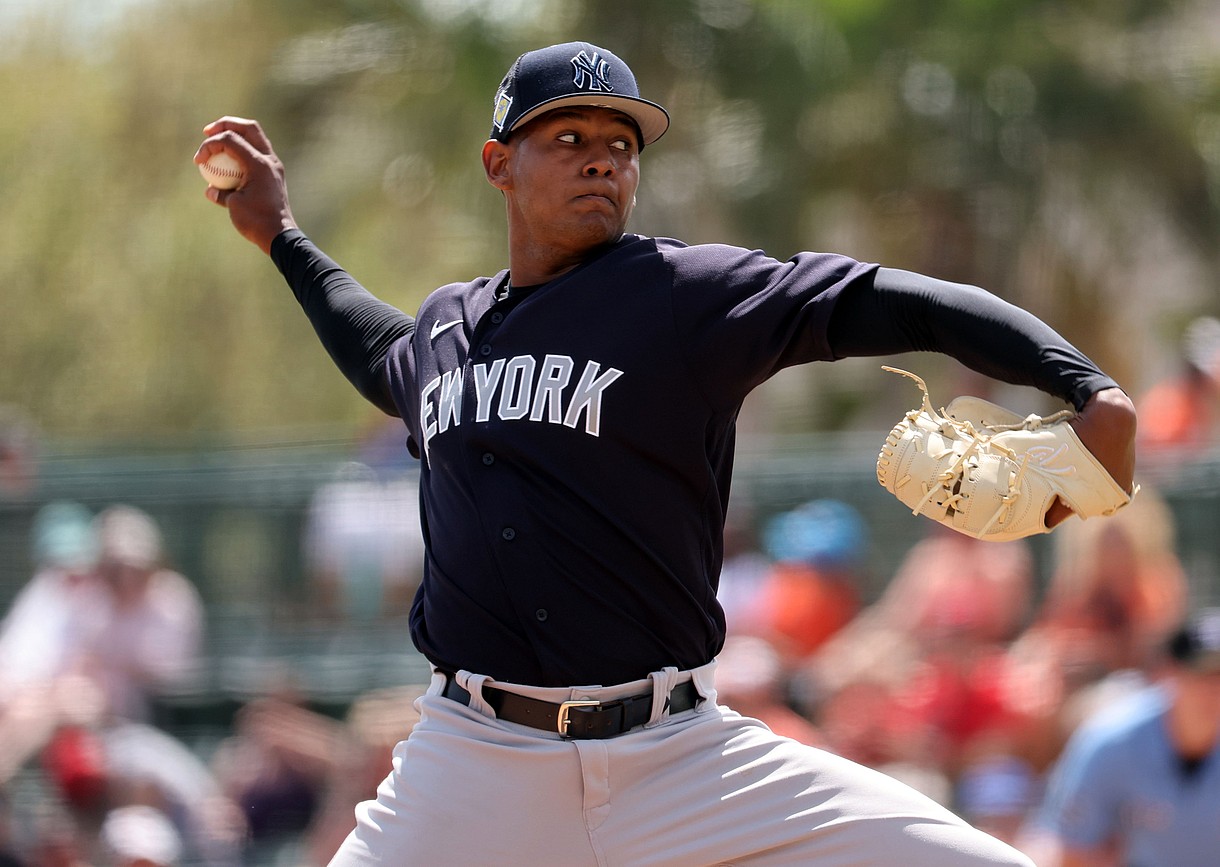
Coming into 2023, I wasn’t shy about my love for former Yankees 1st Round pick Clarke Schmidt. The 27-year-old RHP introduced a brand-new cutter and started utilizing it to generate swings-and-misses, and with him competing with the incumbent 5th starter in Domingo German, Jhony Brito was largely overlooked.
With no MLB experience, Brito simply wasn’t going to get much run in the rotation when arms ahead of him on the depth chart had the requisite MLB experience and better stuff on paper. Brito is a testament to taking advantage of a great opportunity, and while he’s far from perfect, he’s displayed early on that he possesses plenty of the tools necessary to succeed long-term as an MLB starter.
While we have a small sample size to work on, we’re slowly seeing the things that make Brito an intriguing starter going forward and, ultimately, why he’s ascended past Schmidt and German for a job in the Yankees’ rotation.
- Yankees News & Buzz: Analyzing the perfect trade target for rotation; Yanks have a $150-million decision on their hands, more
- Yankees sign former Mets, Red Sox, and Blue Jays catcher to minor league deal
- Yankees add versatility to the mix with Zack Short MiLB signing
Maintaining Increases in Velocity From Spring Training
One of the biggest question marks I had about Jhony Brito from his first start was whether his velocity uptick from the 2022 MiLB season was due to adrenaline or simply just the velocity he operates at normally now. Baltimore wasn’t overly warm either, so this would serve as a good test for Brito as he would pitch in 50-degree weather at night in the sequel to his Opening Day gem. While the contents of this start were certainly a step back from his six-strikeout performance against the Giants, the velocity gains were still there. Averaging over 95 MPH on his sinker and four-seam fastball, Brito was able to utilize these fastballs to generate soft contact and big outs.
Just like in his outing against the Giants, the Orioles failed to record an extra-base hit against Brito, who held batters to a combined 1 for 8 against his fastballs. With a 56.3% groundball rate in this start, it allowed for easy plays for his defense and opportunities to generate quick outs after a grueling first inning. This increase in velocity is massive, especially for a pitch like his sinker, which has maintained a strong Stuff+ in Spring Training and in the early goings of the regular season. The mid-90s velocity with ~17 inches of horizontal run makes it an ideal pitch to jam righties with for groundballs and called strikes against lefties.
Jhony Brito has a below-average four-seam fastball in shape, but he’s flashed the ability to generate decent ride on it when need be. It’s a work in progress, but the sinker being such a high-level offering for soft contact, is going to be a huge help early on. Velocity gains are an easy way to see upticks in stuff, which, when coupled with consistent command, will lead to plenty of ideal outcomes. His fastballs aren’t pitches that you look at to generate high whiff totals but rather to either set up an offspeed/breaking pitch or to get an ideal batted ball in the form of a weak pop-up or a groundball.
His sinker maintained the shape it had in that first outing of the year, where he generated a 117 Stuff+, nearly two standard deviations better than the league-average sinker. Once again, the average sinker registered a 92.6 Stuff+ in the model, with 13.6 points representing one standard deviation. Brito truly has an elite-level pitch in this sinker, and as the Yankees continue to work with him mechanically and they get him more reps at the Major League level, he’ll only get better at consistently finding the zone with that pitch.

With that established, we know that his fastballs have room to grow and continue to blossom into better offerings that get consistently strong results, but what about his breaking ball? Well, despite its subpar shape, it’s generating strong results, and the Yankees could be looking at the development of a solid breaking ball offering for the young right-hander.
The Development of a Curveball
We’ve seen the scouting reports on Jhony Brito, for as excellent as his changeup and sinker are, he doesn’t have a quality-breaking pitch to tie together his arsenal. That being said, the results early on would suggest he has a much better breaking ball than I initially gave him credit for. In his first outing, he generated just 6″ of horizontal sweep on his curveball, but it still had a 60% Called Strike + Whiff%. Its shape isn’t as big as other breaking balls you see in the league, but the curveball works as a pitch he can occasionally mix in alongside his fastballs and changeups to throw off batters and get strikes.
In his start against the Orioles, while he struggled with his strikeout-to-walk rate, his curveball averaged 10″ of horizontal sweep with a 57% Called Strike + Whiff%. It’s genuinely a strong pitch, and I could see Brito throwing it more in two-strike counts to put stubborn batters away. Hitters have begun to sit on the changeup, as we saw with Cedric Mullins flipping one of his changeups the other way to lead off the game on two strikes. With a 40% Whiff% in its small sample of use so far, we could definitely see it working as a quality-breaking ball offering going forward.
It keeps batters honest, especially with that wipeout changeup in his arsenal. We’ll need a larger sample size with the pitch before we draw any conclusions, but Brito’s flashed an ability to generate swings and misses on the pitch. That doesn’t mean dramatically increasing the usage of the pitch, as some pitches work better when used sparingly, but it should certainly help him whenever he loses command of other pitches or just wants to throw off a hitter sitting on a changeup that they don’t end up getting.
In Spring Training, his curveball had a Stuff+ of 109.8, his best pitch by the metric in Spring, and while it dropped ~10 points in his first outing, he’s seemed to bring back the horizontal sweep he had on it earlier in Spring. It’s an inconsistent pitch in terms of shape right now, but as he continues to work with Matt Blake and pitch in games, the comfort level with the pitch should improve.
How Can Jhony Brito Build Off of His Last Start?
Jhony Brito failed to get ahead of the count often against the Orioles, generating a mere 35% first-pitch strike rate, which constantly put hitters in a position to be patient and lay off his changeup and curveball more frequently. Attacking the strike zone is something Brito needs to do early and consistently, especially since he doesn’t have elite-level strikeout stuff. Some hitters are going to try to ambush him, and some will do so successfully, but Brito certainly has the pitch mix to go out and attack batters. There’s a difference between not having strikeout stuff and not having the stuff to live in the strike zone, and Brito is an excellent example of this.
It’s early on, and he’s a rookie, so looking to lower his walk rate from 8.1% is an excellent starting point here for Brito. It’ll open up more opportunities to try to generate chases on his wicked changeup, and that’s ultimately what pitching is all about. Getting to two strikes early creates added aggression for hitters, leading to more chases and swings at pitches that result in strikeouts or extremely poor quality of contact. He’s figured out the quality of contact aspect already, with a 56% groundball rate, 87.7 MPH average exit velocity, and 26.9% hard hit rate. He’s doing a lot of things well right now, it’s just a matter of finding comfort as an MLB regular.

It’s a long season, and I want to make it clear that I’m not concluding that Brito is a good starter just two starts into his career. That being said, the command and the pitches are there to find success at the Major League level, he just has to continue to build off of what he’s done early on. On top of that, the Yankees need to give Jhony Brito a fair shot to stay in the rotation. Domingo German is on the bump tonight against the Cleveland Guardians, and if he isn’t able to out-pitch Brito, the Yankees shouldn’t reward him with a rotation spot over Brito.
For those wondering what you realistically do with Domingo German if Brito stays in the rotation, I would reference my offseason takes on German. I thought it would be smart to flip him for an outfielder since he was a “surplus”, but injuries make pitching depth a constant necessity. It’s not being a pessimistic fan to say that we’re likely to get more injuries to our rotation as the season goes on, and whenever that occurs, you’ll have a strong depth starter. Schmidt is likely just a reliever at this point, so developing him as such could end up reaping massive benefits for the Yankees as, over the next two years, these relievers hit free agency:
- Clay Holmes
- Jonathan Loaisiga
- Wandy Peralta
- Lou Trivino
- Tommy Kahnle
On a team that wasn’t win-now, Schmidt would be given much more room to develop as a starter, but that’s just not what’s best for the team. As for Brito, he has an opportunity to grab that final rotation spot and become a long-term solution in the rotation. Both Luis Severino and Frankie Montas are free agents at the end of the year, with German a free agent after the 2024 season, creating an incentive for the Yankees to develop an in-house starter to hold a spot down going forward. There are going to be growing pains with Brito as he navigates through his first season as an MLB starter, but the Yankees definitely have a talented pitcher in their hands.
More about: New York Yankees